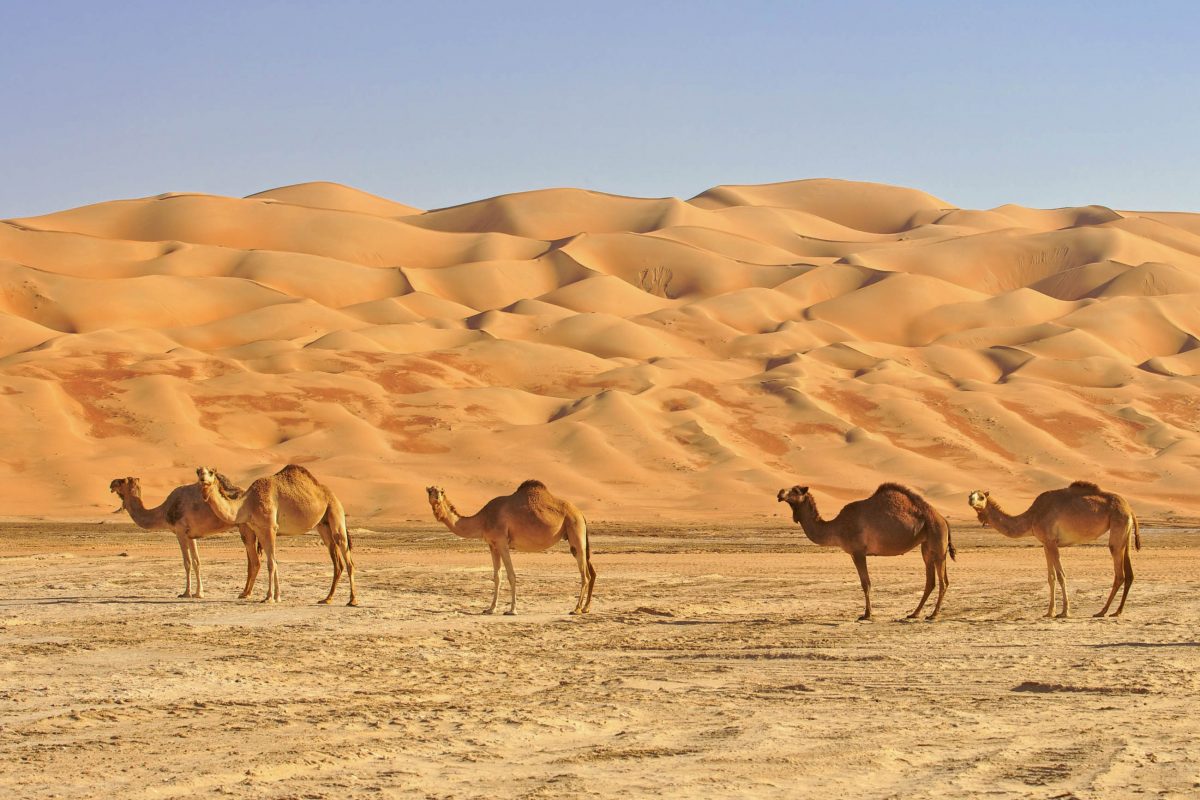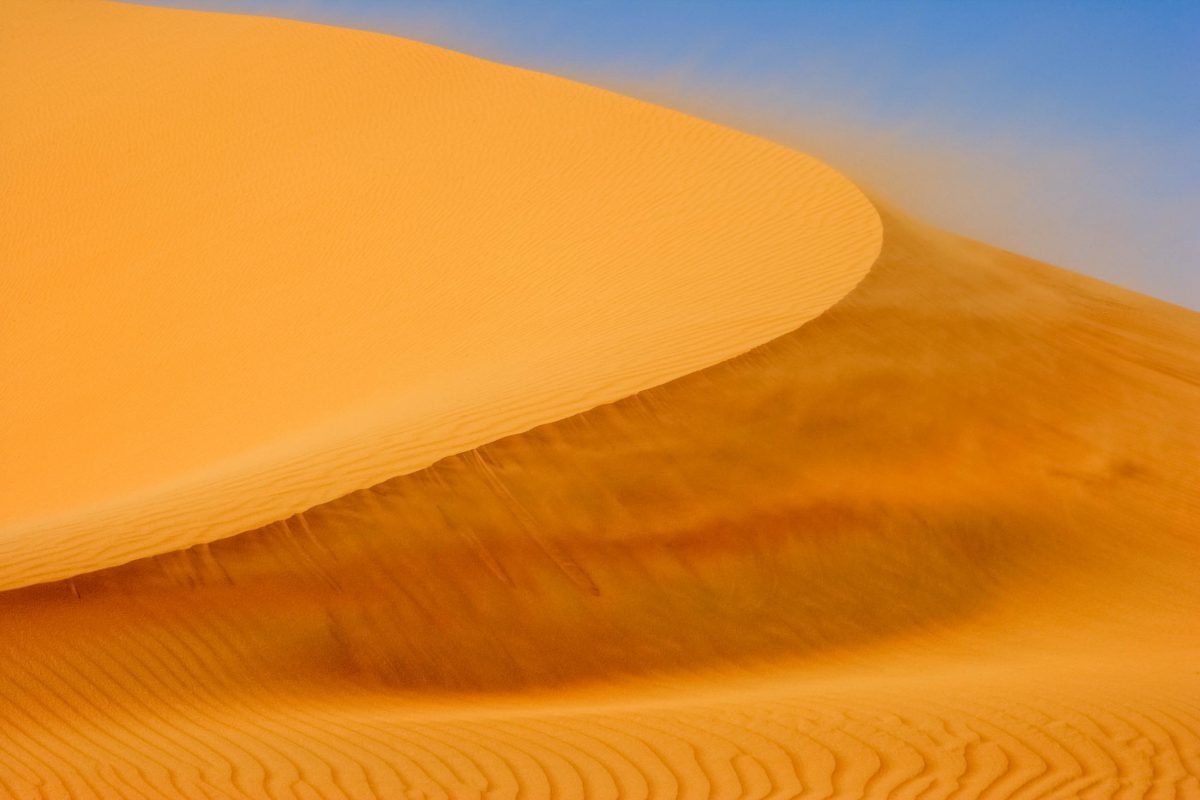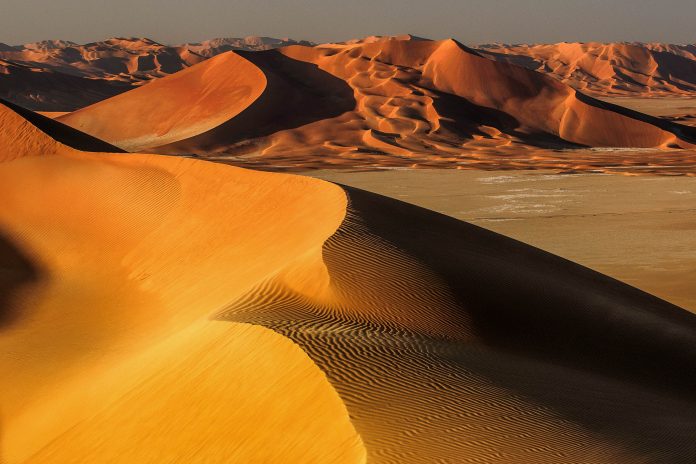Die Rub al-Khali im Süden der arabischen Halbinsel ist das größte Sandmeer der Welt und zählt zu den lebensfeindlichsten Regionen unseres Planeten. Das völlig unbewohnte Gebiet macht seinem Namen „Leeres Viertel“ alle Ehre.
Die Rub al-Khali im Süden der arabischen Halbinsel ist mit einer Fläche von rund 780.000 Quadratkilometern – beinahe so groß wie die Türkei – die größte Sandwüste der Welt. Viele glauben, dieser Titel fiele der Sahara zu, doch diese besteht ja nur zu insgesamt 20% aus Sandwüste und die größte so genannte Erg (Sandfläche) in Nordalgerien bedeckt „nur“ eine Fläche von etwa 150.000 Quadratkilometern.
Inhaltsverzeichnis
BILDER: Rub al-Khali (Leeres Viertel)
Fotogalerie: Rub al-Khali (Leeres Viertel)
Das „Leere Viertel“ ist tatsächlich leer
Die Rub al-Khali liegt im Süden der arabischen Halbinsel und erstreckt sich über die Vereinigten Arabischen Emirate, Saudi-Arabien, Jemen und Oman. Sie macht ihrem Namen „Leeres Viertel“ alle Ehre, denn in der Rub al-Khali lebt tatsächlich kaum eine Menschenseele. Lediglich Spinnen, ein paar Nagetiere und vereinzelte Pflanzen sind in der Rub al-Khali anzutreffen, die die gewaltigen Temperaturschwankungen vom nächtlichen Gefrierpunkt bis zu 60°C tagsüber aushalten.
Die erste Durchquerung dieses völlig lebensfeindlichen Gebietes gelang auch erst im Jahr 1946. Der britische Entdecker Wilfred Thesiger wollte damals nach der Heuschreckeninvasion herausfinden, wo die Plagegeister herkamen und erhielt von König Ibn Saudi, dem ersten König des modernen Saudi-Arabien, die Erlaubnis, nach ihren Nestern zu suchen.
Tipp: Wer Genaueres über Thesigers Forschungsreisen wissen möchte, sollte das Museum von Salalah besuchen.
Bis heute ist die Rub al-Khali – abgesehen von Satellitenbildern, kaum erforscht. Die Beduinen haben sich ganz an den Rand der Wüste zurückgezogen und auch die Karawanenzüge, die bis etwa 300 nach Christus noch unterwegs waren und der legendären Stadt Ubar zu ihrem Reichtum verhalfen, gehen das Risiko einer Durchquerung nicht mehr ein.
Unterwegs in der Rub al-Khali

Trotz ihren lebensfeindlichen Bedingungen übt die endlose Leere der Rub al-Khali eine Faszination auf den Menschen aus. Nirgendwo sonst kann man den Stress und den Lärm der Geschäftswelt so sehr hinter sich lassen, wie in der völligen Stille der Wüste.
Ausflüge in das spektakuläre Sandmeer sollten allerdings auf keinen alleine und nur mit einem ortskundigen Führer unternommen werden! Lediglich am Rand der Wüste kann man mit einem Geländewagen auch ohne komplette Wüstenausrüstung in die ersten, bereits sehr mächtigen Dünen hineinfahren.
Tipp: Einige Reiseanbieter veranstalten Expeditionen mit Geländewägen in die Rub al-Khali. Die mehrtägigen Touren inklusive dem atemberaubenden Sternenhimmel in der Nacht sind absolut unvergessliche Erlebnisse!
Liwa-Oase
Im Süden von Abu Dhabi, das zu den Vereinigten Arabischen Emiraten gehört, schimmert inmitten der goldgelben Sandwüste die grüne Sichel der rund 100km langen Liwa-Oase. Die riesige Oase im Norden der Rub al-Khali ist nicht ganzheitlich bepflanzt und besteht eigentlich aus 50 kleineren Oasen und knapp 40 Dörfern, in denen an die 20.000 Menschen wohnen. Der lebensspendende Fleck in der Rub al-Khali ist über die beiden Straßen E12 und E65 zu erreichen, die jeweils weiter auf die E11 Richtung Abu Dhabi-Stadt führen.
Kamel-Rennen in der Liwa-Oase

Wer Kamelen angetan ist, sollte die Liwa-Oase unbedingt Mitte Dezember besuchen. Jedes Jahr zu dieser Zeit findet das traditionelle Al-Dhafra-Festival statt. Zu diesem Anlass treffen sich Kamelbesitzer aus den Vereinigten Arabischen Emiraten, dem Oman, Bahrain, Katar und Saudi-Arabien zum alljährlichen Kamelrennen.
In einer faszinierenden Stadt aus Beduinenzelten wird nicht nur das schnellste, sondern auch das schönste Kamel gekürt, außerdem gibt es zahlreiche Märkte und traditionelle Veranstaltungen.
Moreeb-Düne

Die scheinbar endlosen Sanddünen der Wüste erreichen eine Höhe von über 200 Metern. Als höchste von ihnen wir die Moreeb-Düne bezeichnet. Von Mezairaa, dem Zentrum der Liwa-Oase führt eine asphaltierte Straße über rund 25km durch die spektakuläre Wüstenlandschaft bis zur Moreeb-Düne. Allein die Anfahrt ist schon eine Reise wert!
Die steile Sanddüne ragt mit einem Steigungswinkel von 50 Grad scheinbar senkrecht in die Höhe. Mit einer Höhe von 120m liegt die Moreeb-Düne über 200m über dem Meeresspiegel und zählt damit auch zu den höchsten Sanddünen der Welt.
Kein Wunder, dass die Moreeb-Düne als perfekter Schauplatz für das so genannte Dune Racing auserkoren wurde. Das sensationelle Spektakel der „Moreeb Dune Cars and Bikes Championship“, bei dem die Teilnehmer in getunten Vehikel versuchen, bis auf den Grat der Düne hinauf zu fahren, zieht jedes Jahr Sporttouristen aus aller Welt an.
Wabar-Krater

Im Jahr 1932 durchstreifte der britische Forscher Harry Philby die Rub al-Khali auf der Suche nach der sagenhaften Wüstenstadt Ubar, die laut dem Koran auf Geheiß Allahs von der Wüste verschluckt wurde. Nach etwa einem Monat stieß er auf ein Gebiet von der Größe eines halben Quadratkilometers, das von weißen Sandstein-Brocken und schwarzem Glas bedeckt war.
Die Analyse ergab, dass manche Brocken von einem Eisenmeteorit stammten, die rundlichen Vertiefungen, die teilweise im Sand schon fast verschwunden waren, bestätigten die Annahme eines Meteoriteneinschlags in der Rub al-Khali. Er nannte die Kraterlandschaft aufgrund einer falschen Übersetzung von „Ubar“ „Wabar“.

Auf modernen Karten sind mittlerweile drei Einschlagskrater sichtbar, von denen der größte einen Durchmesser von 116m aufweist. Das gewaltigste außerirdische Eisenstück, das daraus geborgen wurde, hat eine Masse von 2,2 Tonnen und ist heute im Nationalmuseum von Saudi-Arabien ausgestellt.
Alle drei Krater sind mittlerweile fast vollständig im Sand verschwunden. Wann der Einschlag des 3.500 Tonnen schweren Meteoriten erfolgte, ist nicht geklärt, Schätzungen reichen von vor 260 Jahren bis vor einigen tausend Jahren.





